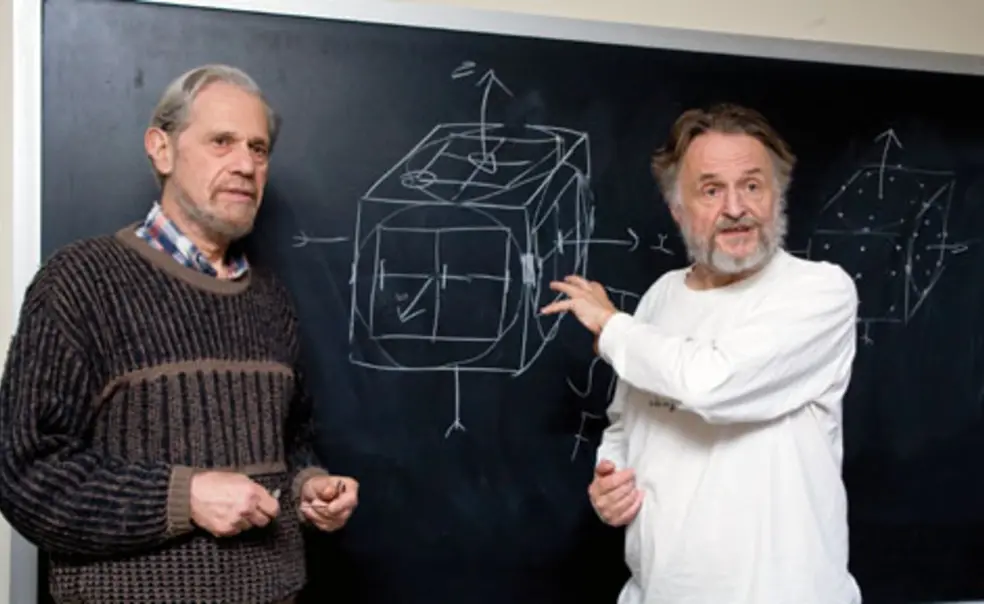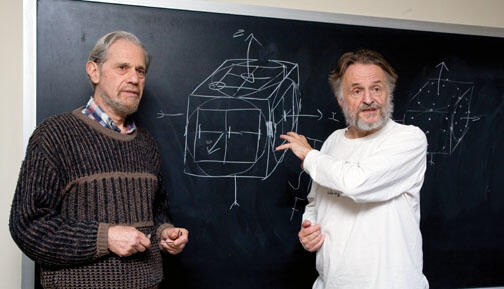Conway Lectures
You may be much closer to the cutting edge of particle physics than you suspect. Just try the following quiz:
- Do you believe that a justice system designed to impartially establish the facts of the case and punish the guilty is fair?
- Do you believe in the efficacy of the scientific method (hypothesis, experiment, proof)?
- Do you agree with Dr. Pangloss (in Voltaire’s Candide) that “all is for the best in this best of all possible worlds”?
If you answered yes, yes, and no to these three questions, then you believe that gluons have free will.
Yes, those tiny elementary particles that make up all molecules along with leptons, photons, neutrinos, and such; actually, if you are free to choose, they all are, too. John Conway and Simon Kochen, professors in Princeton’s math department, proved it three years ago. The way they phrase it is a bit more precise: “If human beings have free will, then elementary particles have free will.” In fact, it even turns out that our free will (if we have it) is most likely a product of our aggregated particles’ free will in the first place. Really.
This spring, Conway presented a series of six lectures in a packed McDonnell Hall to explain this proof to the general public, an unusual habit of his in a field that isn’t big on mass promotion. Conducted in his famed low-key but arresting style, the lectures contain nuggets such as:
- Why it can’t be proved that free will definitely exists in the first place (a nod to the determinists)
- How you experimentally establish that a particle has free will: You ask it a question (this has a Dr. Dolittle feel about it)
- Why the easiest way to conduct the experiment is to send your friend to Mars (blame Einstein)
- Why free will is different from a random event (in a word, timing)
Videos of the lectures have been posted on the Web, which is fortunate; either the presentations or the mathematical proof are necessary to understand much beyond the simple statement of the theorem. Since the lectures are in six pieces and run more than five hours in total, PAW Online has put together a do-it-yourself guide to enjoying some or all of them, as you freely choose (wink, wink). Here are both a short description of each lecture and some approaches to viewing the material according to your own interests. Enjoy.
Lecture 1 – INTRODUCTION. Meet John Conway; hear about Simon Kochen and how the theorem came about. Thoughts on senility. Free will and determinism in science and philosophy over the last two millennia; the implications of Newtonian and quantum mechanics. What Conway and Kochen mean by “free will.” What the theorem does, and doesn’t, imply about behavior. A brief introduction to the three underlying principles of the theorem: SPIN, FIN, and TWIN. The idea of talking to particles, and how it’s like playing 20 questions with your sisters. To view a video of this lecture, click here.
Lecture 2 – THE KOCHEN-SPECKER PARADOX (1967). Measuring a particle’s spin: It tells you. The SPIN axiom, 101 property, and M.C. Escher. Demonstrating the paradox, clarifying Heisenberg’s Uncertainty Principle, disproving Leibniz’s Sufficient Reason. The EPR effect and the TWIN axiom. The FIN axiom and why you need large distances to experimentally test the Free Will Theorem. Why the chair doesn’t spontaneously move. To view a video of this lecture, click here.
Lecture 3 – THE PARADOXES OF RELATIVITY AND ENTANGLEMENT. Review of SPIN and TWIN, which can be operationally demonstrated, and FIN, which can’t. Why the speed of light is independent of the observer. The way time really works. Perceived sequences of events. Experimental ways of implying FIN. Why you can’t go back, kill your own ancestor, and change the time line. To view a video of this lecture, click here.
Lecture 4 – THE PROOF OF THE FREE WILL THEOREM. Frightening people off. The story so far; restating the theorem. Sending your friend and his particle to Mars. The meaning of “free.” Entanglement review: Why twinned particles can’t communicate instantaneously. The proof: disproving the contrary. Strictly locating the free decision: The universe did it! To view a video of this lecture, click here.
Lecture 5 -- SCIENTIFIC CONSEQUENCES. Old news to physicists. Descartes and Leibniz disproved. The Janus universe. Left/right symmetry. Satisfying Curie. Hidden variable theories. Random vs. non-deterministic; backgammon. Random vs. free. Moral responsibility. The state of a particle and collapse. Reduction and the conscious mind. Beyond quantum mechanics. The second time around -- again. To view a video of this lecture, click here.
Lecture 6 – ARGUMENTS FOR FREE WILL. Consistency proofs and truth. Godel and truth. Determinism in philosophy and science departments. Scientific experiments and free will. Surprise and logic. The incompleteness of quantum mechanics. Incomplete theories. The composition of human free will. Ineluctable concepts. Evidence for determinism? Physics, Teddy Roosevelt, time, and free will. Time reversibility. To view a video of this lecture, click here.
Your exploration of the material will most likely depend on your perceived available time (relative or otherwise), your level of detail fixation, and your willingness to accept de facto Conway and Kochen’s SPIN, TWIN, and FIN axioms. Here are some possible approaches:
Strategy 1 – the Plunger. For the time-constrained Popular Mechanics devotee, watch lecture four and see the proof. Let it motivate you to continue to lectures five and six, or not.
Strategy 2 – the Backgrounder. For the history buff, watch the first 35 minutes of lecture one for a little context, skip to four for the proof, then follow your bliss.
Strategy 3 – the Processor. For one who treasures the journey, watch the first three lectures and see if you can intuit from SPIN, FIN, and TWIN the logic of the theorem as derived from relativity and quantum mechanics. If this satisfies you, feel free to stop.
Strategy 4 – the Bottom Liner. For one at ease with relativity and quantum mechanics and willing to accept the theorem, start on lecture five and continue to the end of six to see Conway’s fascinating take on its implications.
Strategy 5 – the Overachiever. For the compulsive, sharpen lots of No. 2 pencils, watch everything, be sure to rewind every time you drop the descriptive thread, make lots of arrows, prepare a schedule for two complete report drafts before Dean’s Date. Repeat.













No responses yet